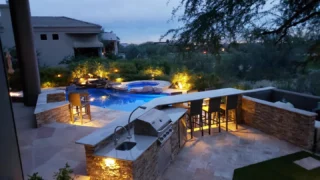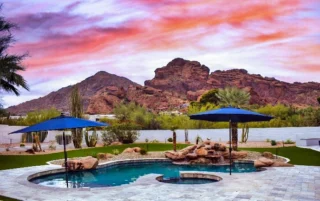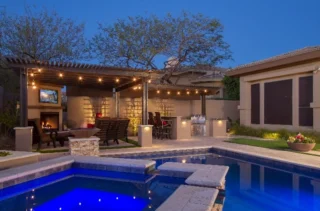Figuring out the best options for your Arizona lawn requires taking many things into consideration. Arizona’s unique climate presents challenges and opportunities for every homeowner. Think Green Inc. is here to help and provide some helpful tips if you’re wondering how to choose between artificial and real grass in Arizona to make the best decision for you.
Understanding Arizona’s Climate
Arizona is known for its hot, arid climate, which can be challenging for maintaining a lush, green lawn. The state experiences high temperatures, especially during the summer months, with little rainfall. This lack of precipitation means that natural grass often requires extra care, including regular watering, to stay healthy and vibrant. However, this also means that any solutions that minimize water usage, such as artificial grass, are appealing.
The intense Arizona sun also impacts the health of natural grass. Direct sunlight can scorch grass, leading to brown patches and a less-than-attractive lawn. Homeowners don’t have to worry about this concern with artificial grass since it doesn’t need sunlight to stay green. It’s important to note that artificial turf often heats up after prolonged sun exposure, which may be risky for homes with pets or young children.
Pros and Cons of Real Grass
The most obvious benefit of real grass is that it provides a natural beauty and feel that homeowners can value and appreciate. It provides a soft, cool surface that feels great to walk around on without shoes and contributes to the local ecosystem by supporting insects and other wildlife.
However, real grass is also much more demanding when it comes to maintenance, particularly in Arizona. Homeowners must invest in an efficient irrigation system to provide the necessary water without wasting resources.
Another consideration is the ongoing care required for real grass, which involves mowing, fertilizing, and treating for pests and weeds. While those who enjoy gardening may find these tasks rewarding, they require extra time and effort. Even with the best care, natural grass might not thrive as well during the hottest months, potentially leading to periods of suboptimal appearance.

Benefits of Artificial Grass
Artificial grass is a popular option because of its low-maintenance nature and consistent aesthetic appeal. It requires basically no upkeep after you install it, and that’s wonderful for those with a set-it-and-forget-it mentality.
Artificial grass doesn’t need watering, mowing, or fertilizing, which can save time and money over the years. One of the primary benefits of artificial grass in Arizona is its durability. It withstands extreme temperatures without fading or dying, ensuring that your lawn looks its best year-round.
Cost Considerations
Cost is a significant factor when choosing between artificial and real grass. Artificial grass seems like the more expensive option at first, but most of that cost comes from the installation. It’s often a one-time investment, as it doesn’t require the ongoing costs associated with maintaining natural grass, such as water, fertilizers, and equipment.
In contrast, real grass typically offers lower upfront costs but winds up requiring additional expenses in the long run from various maintenance needs. Homeowners must consider the long-term financial commitment needed to keep natural grass healthy and vibrant, including potential expenses for repairs or reseeding if parts of the lawn die.
Environmental Impact
Many homeowners try to consider and reduce their environmental impact. Real grass contributes to air quality by absorbing carbon dioxide and releasing oxygen. It also supports biodiversity, providing habitat for insects and other small creatures. However, maintaining a real grass lawn in Arizona can lead to high water consumption, which is a critical concern in this arid region.
Artificial grass doesn’t require water, but the synthetic materials aren’t as environmentally friendly as natural grass throughout its lifecycle. Investing in artificial turf made from recycled materials can somewhat reduce this negative impact. Homeowners interested in eco-friendly options should research the manufacturing processes and materials used in different brands of artificial grass to make an informed choice.

Aesthetics and Feel
Homeowners must consider the general look and feel of each option for their lawn when wondering how to choose between artificial and real grass in Arizona. Real grass offers an authentic appearance and texture that many people love. Its natural imperfections can create a charming, lived-in look that adds character to a home.
While artificial grass is much more realistic in look and feel these days than it was several years ago, it rarely manages to capture that exact level of charm. Despite these advancements, the feel of artificial grass may not match the softness of natural grass, which is something to consider if you or your family spend a lot of time barefoot on the lawn.
Maintenance Requirements
Maintenance is a factor that homeowners must consider no matter which path they take. Artificial grass requires minimal upkeep, needing only occasional brushing to remove debris and maintain its appearance.
Real grass requires regular mowing, watering, and fertilizing, which can be time-consuming. Homeowners also need to be more vigilant with real grass and maintain weeds and pests to prevent them from damaging the lawn.
Artificial grass offers peace of mind to those with busy lifestyles or who travel frequently, knowing their lawns will remain pristine without constant attention. On the other hand, some homeowners find the care of real grass to be a relaxing and rewarding hobby.
Longevity and Durability
A distinct advantage of artificial grass is its longevity, often lasting 15 years or more with proper care. This fake turf can withstand heavy use and harsh weather conditions, making it a good option for high-traffic areas or places with extreme weather. The most common negative side effect is regular use, which can result in visually displeasing flattening and require replacements.
Real grass, while not as durable in harsh conditions, can rejuvenate with proper care, allowing it to last indefinitely as long as homeowners can maintain it. Seasonal changes can affect the appearance of natural grass, leading to periods of dormancy, which can impact its look.
Look no further than Think Green, Inc. if you’re ready to transform your Arizona lawn into a stunning, low-maintenance oasis. As the leading landscape designers in Phoenix, we specialize in creating beautiful outdoor spaces to meet your specific needs. Our expert team is here to help, whether you want artificial grass for its convenience and water conservation benefits or a lush natural lawn that enhances your home’s ecosystem. Contact Think Green, Inc. today, and let us design a landscape that you’ll love for years to come.




